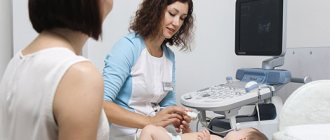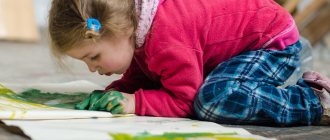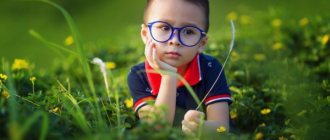In the period from the 8th to the 10th month of the first year of life, it is quite possible to use most of the exercises of the 4th complex of children's restorative gymnastics. However, some experts recommend introducing new exercises into your baby’s daily activities, since the child’s rapidly progressing motor skills need adequate support from adults. There is another important argument in favor of introducing new exercises into the gymnastics complex - the little person really loves new impressions and sensations. You can master the exercises below gradually, alternating them with the exercises of the 4th complex that are already familiar and loved by your baby. It only remains to note that the exercises recommended in this note can be used by mothers and fathers when working with healthy children - children observed by a pediatrician or neurologist for any problems may need special physical therapy complexes. The latter are usually carried out under the guidance of a qualified specialist.
Torso rotations.
The starting position of the child is the same. Periodically placing objects of interest to the child (a toy, a TV remote control, an old computer “mouse”, etc.) either to the right or to the left of the baby, ensure that he turns in the right direction and reaches for the object with his hands, trying to take possession of it. . The exercise is performed 3-4 times on each side. Be sure to provide your child with the opportunity to achieve the goal - otherwise interest in doing the exercise will sharply decrease. In addition, the little person may simply get angry, or even seriously upset with you :)
Complex of morning exercises for children 1.5–2 years old
Fokina Taya
Complex of morning exercises for children 1.5–2 years old
September
1 – 2 week
Where are our hands?
Walking in a flock behind the teacher. At the signal to stop, turn to the teacher.
General developmental exercises.
1. “Show your hands.” (The teacher, smiling, pronounces simple words that are understandable to the child and shows actions - the children repeat)
I. p.: legs slightly apart, hands below. Raise your hands in front of you: “Here they are ( “here are the hands”
)”, lower (say:
“Hid your hands”
). Repeat 4 times.
2. “Hide your hands.”
I. p.: The same. Move your arms back, return to the starting position. After a few days, you can complicate the exercise: sit down, put your hands on your knees, stand up, lower your hands. Repeat 4 times.
Walking in a flock behind the teacher.
3 – 4 week
Big and small
Walking in a flock behind the teacher. At the signal, turn to the teacher.
General developmental exercises.
1. “How big we have become.”
I. p.: legs slightly apart, hands down. Raise your hands up, lower them. Repeat 4 times.
2. “How small we were.”
I. p.: the same. Sit down, put your hands on your knees, stand up, lower your hands. Repeat 4 times.
Walking in a flock behind the teacher.
October
1 – 2 week
Birds
Walk in a flock, gradually move to running in a flock and end with walking in a flock.
General developmental exercises.
“Birds flap their wings” and. p.: legs slightly apart, hands down. Raise your arms to the sides, wave them, lower them. Repeat 4 times.
“The birds are pecking the grains.” I. p.: the same. Sit down, tap your fingers on your knees, stand up. Repeat 4 times.
Walking in a flock.
3 – 4 week
Bubble
Walk in a flock, gradually move to running in a flock, end with walking in a flock.
General developmental exercises.
1. “Let’s blow a bubble.” I. p.: legs slightly apart, hands down. Spread your arms to the sides and lower them. Repeat 4 times.
“The bubble burst.” I.p. The same. Sit down, stroke your knees, stand up. Repeat 4 times.
Walking in a flock.
November
1 – 2 week
Drum.
Walk in a flock, start running in a flock, end with walking.
General developmental exercises.
"Big Drum" I. p.: legs slightly apart, hands below. Raise your arms to the sides, lower them. Repeat 4 times.
“Let's play the drum.” I. p.: legs slightly apart, hands below behind the back. Bend over, tap your knees, say “boom-boom”, straighten up. Repeat 4 times.
Accelerated walking behind the teacher. Finish with a calm walk.
3 – 4 week
Trees
Walking in a flock, short running in a flock, ending with walking.
General developmental exercises
1. “The leaves are rustling.” I. p.: legs slightly apart, hands down. Raise your arms up, wave them, say the sound “SH-SH-SH”, lower them. Repeat 4 times.
2. “The trees are swaying.” I. p.: the same. Lean slightly to the left, then to the right, say “Sh-Sh-Sh”, straighten up. Repeat 6 times. ,
“Bushes.” I. p.: the same. Sit down, put your hands on your knees, stand up. Repeat 4 times.
Walking on toes. Walking in a flock.
December
1 – 2 week
Hide and seek
Walking in a flock, short running, walking in a flock.
General developmental exercises on chairs
1. “Show your hands.” I. p.: sitting on chairs, legs slightly apart, hands on knees. Extend your arms forward, show your palms, and lower them. Repeat 4 times. .
2. “Hide your head.” I. p.: the same. Lean forward, lower your head, straighten up. Repeat 4 times.
“Squat.” I. p.: legs slightly apart, hands on the back of the chair. Sit down, hide behind a chair, stand up. Repeat 4 times.
Walking on toes. Walking in a flock.
3 – 4 week
Show your hands.
Walking, short running in a flock. Form into a semicircle.
General developmental exercises
1. “Show your hands.” I. p.: legs slightly apart, hands behind back. Raise your arms in front of you, palms up, return to the starting position. Repeat 4 times.
2. “Hands on knees.” I. p.: feet shoulder-width apart, hands below. Lean forward, put your hands on your knees, straighten up. Repeat 4 times.
3. “Hide your hands.” I. p.: the same. Sit down, hands on knees, stand up, lower your hands. Repeat 4 times.
Walking on toes. Walking in a flock.
January
1 – 2 week
Bubble.
Walking and short running one after another. Line up in a semicircle.
General developmental exercises
1. “Let’s blow a bubble.” I. p.: legs slightly apart, hands down. Raise your hands to your mouth, say “fff,” lower them and hide them back. Repeat 4 times.
2. “Check the bubble.” I. p.: the same. Lean forward, tap your knees, say “Knock-Knock”, straighten up. Repeat 4 times.
“The bubble burst.” And. p.: the same. Sit down, put your hands on your knees, say “clap”, stand up. Repeat 4 times.
Walking on toes. Walking one after another.
3 – 4 week
Hide and seek
Walking in a flock, short running, walking in a flock.
General developmental exercises on chairs
1. “Show your hands.” I. p.: sitting on chairs, legs slightly apart, hands on knees. Extend your arms forward, show your palms, and lower them. Repeat 4 times. .
2. “Hide your head.” I. p.: the same. Lean forward, lower your head, straighten up. Repeat 4 times.
“Squat.” I. p.: legs slightly apart, hands on the back of the chair. Sit down, hide behind a chair, stand up. Repeat 4 times.
Walking on toes. Walking in a flock
February
1 – 2 week
Watch
Walking and running one after another. Form into a semicircle. General developmental exercises
1. “The clock is ticking.” And. p.: legs slightly apart, arms down.
Swinging your arms back and forth (Fig. 15)
. Repeat 4 times.
2. “Let's check the clock.” And. p.: the same. Lean forward, tap your knees, straighten up. Repeat 4 times.
3. “The clock is ringing.” I. p.: the same. Sit down, tap your knees, say “ding-ding”, stand up. Repeat 4 times.
Walking on toes. Walking one after another.
3 – 4 week
With a rattle.
Walking and running one after another. Walking on toes. Form a circle.
General developmental exercises with a rattle.
1. “Shake the rattle.” I. p.: legs slightly apart, hands below, rattle in the right hand. “Rattle” - raise the rattle up, shake it, lower it down. Repeat 3 times. Transfer the rattle to the other hand and perform the same exercise.
2. “Knock with the rattle.” I. p.: the same. Bend over, tap the rattle on your knees, say “ding-ding,” and you straighten up. Repeat 3 times. Do the same with your left hand, after transferring the rattle.
3. “Put down the rattle.” I. p.: the same. Sit down, put a rattle on the floor, straighten up, sit down, take the rattle, straighten up. Repeat 2 times. Place one rattle and perform the same exercise.
Running and walking one after another.
March
1 – 2 week
Birds
Walking and running one after another. Walking on toes. Formation in a circle.
General developmental exercises.
1. “The birds are flapping their wings.” I. p.: legs slightly apart, hands below. Raise your arms to the sides, wave them, lower them down. Repeat 4 times.
2. “Birds drink water.” I. p.: too. Lean forward, move your arms back, straighten up. Repeat 4 times.
“The birds are pecking the grains.” I.p. the same. Sit down, tap your fingers on your knees, stand up. Repeat 5 times.
Running and walking one after another.
3 – 4 week
With a checkbox.
Walking and running one after another. Walking on toes. Formation in a circle.
General developmental exercises with a flag
1. “Show the checkbox.” I. p.: legs slightly apart, flag at the bottom in the right hand. Raise the flag, wave it, look, lower it down. Repeat 3 times. Transfer the flag to your left hand and perform the same exercise.
2. “Tap the flag.” I. p.: the same. Bend over, tap the flag stick on your right knee; straighten up. Repeat 3 times. Transfer the flag to your left hand, perform the same movements, but tap the flag on your left knee.
3. “Place the checkbox.” I. p.: the same. Sit down, put the flag down, straighten up, sit down, take the flag, stand up. Repeat 2 times.
Run after each other. Walk calmly one after another.
April
1 – 2 week
Drum.
Walking and running one after another. Walking on toes. Formation in a circle.
General developmental exercises
1. “Big drum.” I. p.: legs slightly apart, hands down. Raise your arms straight to the sides and lower them. Repeat 4 times.
2. “Let’s play the drum.” I. p.: feet shoulder-width apart, hands below behind the back. Bend over, tap your knees, say “boom-boom”, straighten up.
3. “Knock your feet.” I. p.: legs slightly apart, hands down. By
tap your feet on the floor, say “knock-knock.” Repeat 4 times.
Short running and walking one after another.
3 – 4 week
Hide and seek
Walking in a flock, short running, walking in a flock.
General developmental exercises on chairs
1. “Show your hands.” I. p.: sitting on chairs, legs slightly apart, hands on knees. Extend your arms forward, show your palms, and lower them. Repeat 4 times. .
2. “Hide your head.” I. p.: the same. Lean forward, lower your head, straighten up. Repeat 4 times.
“Squat.” I. p.: legs slightly apart, hands on the back of the chair. Sit down, hide behind a chair, stand up. Repeat 4 times.
Walking on toes. Walking in a flock.
May
1 – 2 week
Train
Walking and short running one after another. Walking on toes.
Formation in a circle.
General developmental exercises
1. “Train”. I. p.: legs slightly apart; arms bent at the elbows (at the waist, fingers clenched into fists. Straighten your arms forward, bend them, say “chu-chu” (Fig. 19)
. Repeat 4 times.
2. “Let's fix the wheels.” I. p.: legs slightly apart, hands down. Lean forward, tap your knees, straighten up. Repeat 4 times.
3. “Let's check the wheels.” I. p.: the same. Sit down, put your hands on your knees, stand up. Repeat 4 times.
Rebuilding from a circle. Running after each other - “the train is moving fast.” Walking.
3 – 4 week
With a rattle.
Walking and running one after another. Walking on toes. Formation in a circle.
General developmental exercises with a rattle.
1. “Let’s look at the rattle.” I. p.: legs slightly apart, hands below, rattle in the right hand. Raise the rattle up, shake it, look at it, lower it, repeat 4 times. Transfer the rattle to your left hand and perform the same movements.
2. “Knock with the rattle.” I. p.: feet shoulder-width apart, rattle below in the right hand. Bend over, tap the rattle on your knees, say “knock-knock”, straighten up. Transfer the rattle to your left hand and perform the same movements.
3. “Put down the rattle.” I. p.: legs slightly apart, rattle below in the right hand. Sit down, put a rattle, straighten up, sit down, take a rattle, stand up. Repeat 3 times.
Rebuilding from a circle. Run after each other. Calm walking.
Walking on all fours.
To perform this exercise, parents need, firstly, to provide the baby with enough space. Secondly, make this space as safe as possible. And thirdly, to use all their imagination so that the child has the proper motivation to move. It is difficult to characterize this exercise quantitatively because the levels of physical activity in different children can vary significantly. Therefore, focus on the baby’s mood: when he gets tired of crawling, the exercise can be considered completed :)
Ball game.
The starting position of the child is standing. Give your baby a small ball in his hands (its spherical shape is best suited for the development of many muscle groups in the arms and torso - in this exercise, at least). Take the ball from the child’s hands, then give it to him again, passing it from the right, then from the left, then from above, then from below. Repeat the manipulations 8 - 10 times, while not forgetting to talk to the baby and praise him - let this exercise become one of the child’s favorite games. There are, of course, other physical exercises for children 6-8 months old - fortunately, loving parents, and even professionals in the field of children's physical education, have a lot of imagination. We really hope that those moms and dads who have experience in this area will share it with everyone who is really interested. Write to us without hesitation.
Gymnastics for children aged 1 year – 1 year and 3 months
- Crawling on all fours
- Walking with support, support and independent walking
- Squatting first with support and then without it
- Crawl through a hoop
- Crawl under an obstacle
- Retrieving a toy from a height
- Torso bends (knees are fixed)
- Climbing onto a sofa, bed, chairs, getting off
- Raising your legs to a lying position to a right angle
- "Bike"
- From a lying position, rise to a sitting position.
- Walking along a narrow path
- Throwing the ball with both hands
- Raising your arms up alternately, boxing movements
- Walking in place while raising your knees high








